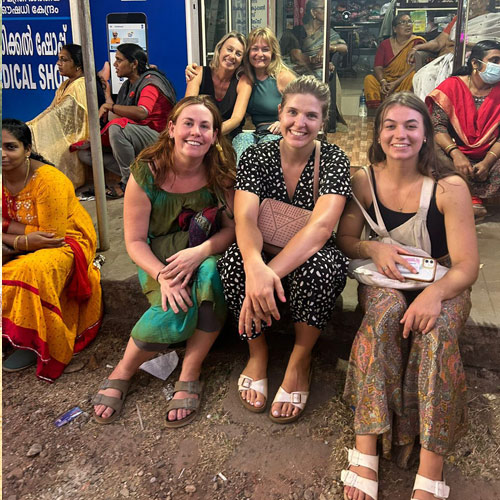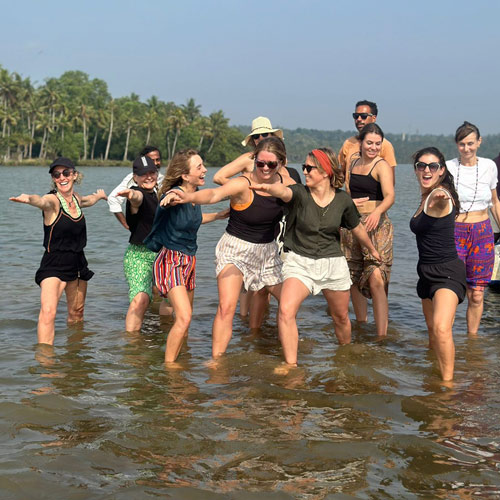Getting into a Yoga Teacher Training or Yoga Certification is one of the most avowed routes for yogis and yoginis aspiring to become serious yoga teacher. The programs offered under yoga TTC work towards enhancing the practice and provide the knowledge required to ace as a teacher of the science. The question is, how to prepare for yoga teacher training? Well, bear in mind whether you’s registering for an online YTT or an in-person course at a Yoga Alliance certified school, it’s always wise to be prepared. With this understanding and in a bid to help you prepare adequately for the training, this comprehensive guide will show you how to set goals, tips on how to keep yourself motivated and finally how to prepare your mind and body for the training.
Why Prepare for a Yoga Teacher Training?
Physical Readiness: Yoga is not an easy training to go through, and at times the participants undergo through some strenuous activities. To discuss the prior physical preparation for the rigorous training, flexibility and strength are the key assets you need to develop.
Mental Clarity: In addition to its physical aspect, yoga was also about behavioral change in the mind. This is a good practice because it will help you to focus and take down knowledge put across effectively.
Emotional Balance: The program can be very stimulating on so many levels and can be quite a roller coaster ride of the emotions at times. As if saying that even if one is physically prepared, he or she still stands a chance to be spoilt by the training then having an emotional readiness can make it easier for the individual to handle the challenges encountered.
How to Prepare for Online Yoga Teacher Training?
Online Yoga Teacher Training is becoming increasingly popular, and this will provide you with useful information about how to prepare for this process.
1. Create a Dedicated Space
Find a space in your home that is quiet, free from distractions, and has no unnecessary items that could be disruptive during yoga and online classes. Make sure that it is filled with fresh air, adequately lit and minimize irrelevant stimuli present.
2. Gather Necessary Equipment
Buy a good yoga mat, blocks, straps, bolsters, and a gadget that you will use to exercise with an instructor via the internet. We must first confirm that the internet connection of the device is strong and constant.
3. Set a Schedule
This should be done to avoid loitering on other online activities hence interfere with the normal YTT lessons as one would undertake in a traditional course. Ensure that there are set timings particular towards practice, learning, and relaxation with a view of avoiding time wastage.
4. Engage with Your Community
Join a list serve, a newsgroup or social networking site for your training program. Patients can refer to their experiences with other trainees through the sharing of knowledge about the various treatments.
5. Stay Organized
All the study references, notes or recording should be arranged in a very systemized manner. To avoid the frustration of losing track of the materials, you can organize your resources using software such as Evernote or Google Drive.
How to Prepare for Yoga Teacher Training at a School in Person?
Traditional yoga teacher training at an internationally recognized Yoga Alliance certified school requires some preparation if you want to benefit fully from it.
1. Search for the right program involves researching a program, the school, and choosing the program to apply to. Choose a Yoga Alliance accredited school and learn your preferred type of yoga that best suits your philosophy. To identify the type of training offered, you must examine the approaches followed in the school, consider the curriculum, and read the available reviews.
2. Travel and accommodation are critical aspects that travelers should factor in to avoid making costly mistakes while planning a trip. You can also ease the burden of traveling long distances if your YTT is at a different location by making early bookings. When selecting a hotel, select one nearest to the training center so that when tired, you don’t have to travel far to get some rest.
3. Pack Wisely
Bring comfortable clothes suitable for practicing yoga in addition to a water bottle, some healthy snacks, and anything else personal that will be required during the session. List any particular items suggested by the school under admission requirements.
4. Prepare Financially
Make sure the training fee, transport, accommodation, and any other miscellaneous cost are incorporated in your funding plan. This, however, should not be done at the cost of expelling a much needed care; thus, it is advisable to get travel insurance.
5. Understand the Curriculum
Educate yourself with the syllabus and readings for the course. It will assist you in getting into the right position and applying yourself properly during your training.
How to Stay Motivated & Inspired During the YTT Program?
Most people know that having goals is important, as well as remaining motivated, but may not understand how to properly set goals, and what to do when motivation starts to wane.
1. Define Your Purpose
Recognize your purpose for practicing YTT. Is it to further your own practice or to teach others about yoga or both, do you have in your mind? This will help you during the training, as having a purpose in mind is important to stay on track of what you are doing.
2. Set Realistic Goals
Set specific, achievable goals. For instance, you may have goals that pertain to executing some postures in a more enhanced manner, understanding more concerning yoga beliefs, or training skills. These goals should be broken into sub goals as they are achievable and are within your competencies.
3. Create a Vision Board
Try to build what is called vision board – the board with photos and relevant quotations which can encourage you. Kindly put it somewhere you can have the chance to glance at it daily so that every day you are motivated by the things you want to achieve.
4. Track Your Progress
It is advised to maintain this as a record. Your yoga journal must include recorded milestones, barriers, and successes encountered during the reflection. Perhaps the most straightforward method of self-reflection is to maintain direction and motivation while assessing past records.
5. Connect with a Mentor
Know someone who has been practicing yoga for many years? Get advice from an experienced teacher or coach. This is why, the help and support of close ones can be incredibly important to help you stay on track. Studying and applying for yoga teacher training course is not an ordinary event and therefore, requires preparation on your mind to ensure that you make a positive impression and get the course of your life time.
1. Establish a Meditation Practice
It is crucial to meditate every day to help achieve and maintain mental perseverance and sharpness. It is well known that 10-15 minutes daily can make the difference.
2. Practice Mindfulness
Practice being mindful at work, in a classroom, when doing the dishes or while walking through a park. Breathe in, breathe out, pay attention to what crosses your mind and what is happening around you. This practice will add to your yoga awareness and practice during yoga teacher training.
3. Learn Yoga Philosophy
This includes those texts that probably form the base of many eastern spiritual philosophies such as the Yoga Sutras of Patanjali, the Bhagavad Gita, and the Hatha Yoga Pradipika. Knowing the philosophy of yoga will enhance your practice as well as give you improved insight for teaching purposes.
4. Develop Emotional Resilience
Studying yoga can be quite an emotional experience for a student, especially for a yoga teacher. The best way is to practicing self-compassion and journaling, and if it gets worse, turn to friends, family or a therapist.
5. Set Intentions
Before going for your YTT, ensure that you have strong intentions of what you wish to get out of the course/program. These should be reviewed as often as is needed in order not to completely get off base.
Yoga Teacher Training Preparation- Your Body
1. Establish a Regular Practice: Consistency is key. Perform yoga exercises frequently; especially those exercises that train your muscles as well as provide flexibility. Integrate two or more segments of poses, breathing exercises, and relaxation procedures.
2. Focus on Core Strength
Chaturanga is fundamental to many forms of yoga, and a solid core provides the strength to do much of the work in the pose. Focus on doing activities that will enhance your core muscles such as the plank, the boat pose, and abdominal twisting.
3. Enhance Flexibility
Introducing mobility exercises for hips, hamstrings and shoulders. Target : 3 sets of 10-15 reps of each done at least once per week.
4. Maintain a Healthy Diet
Avoid the consumption of excessive amounts of processed foods and take regular meals with a focus on fruits, vegetables, whole grain, and lean proteins. Drink water often and steer clear of such foods that are fast foods.
5. Prioritize Rest and Recovery
They recommended proper sleep and a proper timetable that should include rest periods. Always pay attention to the signals your body is giving as not training or exercising is not the best thing to do but overtraining can also hurt.
More Tips for Yoga Teacher Training Prep-Up
1. Stay Open-Minded
The best thing which you will have to accept is the acceptance of new styles and techniques in your field. Dive into the water within yoga and do not be afraid to move into other styles even if they are not familiar to you before.
2. Practice Self-Care
Keep a sharp eye on the state of your body, mind, and soul. Activities you should include are activities that promote relaxation to help you renew your energy for the new week. Take a nature walk or a bath or read a book.
3. Build a Support Network
Proceed to the next lessons, get acquainted with other participants and the teacher; join a community of yoga enthusiasts. Finding friends and other family members can help give one love and support, as well as someone who understands what one goes through.
4. We can have a very optimistic general education by just staying curious and asking questions.
Be confident in yourself and ask questions if something is unclear or if there is something you don’t understand. This should not be a source of worry since curiosity is something that is found only in a true yogi or yogini and this curiosity will definitely improve the learning process.
5. Enjoy the Journey
Do not forget that you are learning from your mistakes and that YTT is a process, not a one-time achievement. On choosing your goals, there are certain tips like enjoying the process, celebrating the achievements no matter how small they are, and being tolerant of your progress.
Prepare Your Body and Mind With these Yoga Techniques at Home
Here are some of the yoga techniques that you can practice at home since they are easy to begin with:
1. Pranayama (Breath Control)
Technique: Begin with basic practices like Anulom Vilom which is the practice of breathing in through the right nostril and out through the left or Kapalabhati which is the practice of rapid inhalation followed by forced exhalation.
Benefits: Strengthens the lungs, helps to release stress and tension, and regulates energy.
2. Dhyana (Meditation)
Technique: Meditation can be practiced, for example, mindfulness meditation or by concentrating on a certain object or the word.
Benefits: Helps in focusing, relieves tension, and contributes to overall wellbeing.
3. Asanas (Postures)
Technique: Integrate some easy movements that are in harmony with Kriyayoga like twisting movements, bending forward, and movements that involve the head going upside down.
Benefits: It provides flexibility, helps in strengthening your body, and prepares one for deeper meditations.
4. Svadhyaya (Self-Study)
Technique: Yoga Philosophy: Take time to read and meditate on what Yogic scriptures and teachings say about Yoga.
Benefits: Expands the knowledge and spiritual development.
5. Ishvara pranidhana or the practice of surrendering to the Divine is the fifth limb of Yoga.
Technique: Prayer or other structured devotional activities can help to develop a feeling of submission.
Benefits: Amplifies a bond with the higher power and results in tranquility.
Yoga Teacher Training is a process of personal growth that covers all aspects of human being, including their mind, body, and soul. In general, it is possible to achieve success in any program – online or traditional school – if one understands his or her goals and stays motivated while maintaining a healthy schedule.
So, now you know how to start a YTT the right way. In fact, as the saying goes, the journey of a thousand miles starts with the first step. Take that step today and let your yoga teacher training be a way to open up a new path to a new you.
Namaste.











